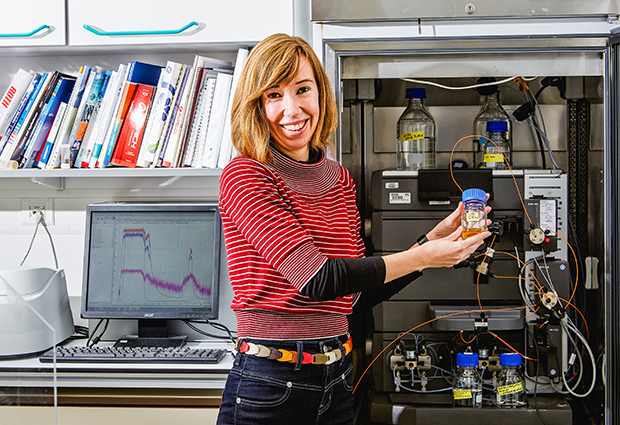
Welcome: Kim Remans
As head of EMBL’s Protein Expression and Purification Core Facility, Kim Remans aims to go further than simply making proteins to order: she wants to offer personalised support and quality control, and invites colleagues to propose challenging projects.

The Protein Expression and Purification Core Facility uses a variety of cells – from bacteria to insect – as living ‘incubators’ for proteins. These proteins could be used for anything from investigating 3D structure to lighting up cells under the microscope. Additionally, the Facility can analyse and assess the proteins, so users get an idea of how close they are to their native state.
People here really try to answer the big questions, and I find that really inspiring!
Why do you do what you do?
I went into structural biology because one of my mentors once told me that when you solve a new structure, you’re the very first person in the world to really see what this molecule looks like, how this whole tangle of loops and helices and strands fits together. You can link this to how it functions and interacts with its partners – I find that so cool! I just love to see how things function on a molecular level.
What inspires you?
Oh, I think it’s mainly my colleagues. People at EMBL are busy with so many different projects and the quality is so high. It’s awesome how varied the activities are but still everybody works together. It’s a privilege to be part of this and to work with all my colleagues and advise them in my field of expertise. I really like that EMBL emphasises fundamental research: people here really try to answer the big questions, and I find that really inspiring!
Name one tool you can’t do without
Our ÄKTAs! These are the machines we use for protein purification, and they’re really the workhorses in our lab – without them we cannot do anything.
Who are your main users? What types of projects do you mostly support?
It’s very varied. Structural biologists want proteins that they will then analyse either through crystallography or electron microscopy; other groups are trying to make antibodies to use in cell assays or pull-downs; others ask for cytokines to study the effect they have on signaling pathways in cells. For the Chemical Biology Core Facility we produce a lot of the proteins they use for screening; for the Genomics Core Facility we produce some proteins that they use in their sequencing assays; for the Light Microscopy Core Facility we produce some fluorescent proteins that are used for all kinds of applications. We also have some collaborations with other institutes, such as the Thorax Clinic here in Heidelberg, where we’re trying to purify proteins from tumour tissues for medical research – it’s very interesting to be involved in this sort of thing as well.
What is your philosophy for running your facility?
Although we are a facility, we really like science. We like it when people come and explain what they want to do – this makes it much easier for us to give sound advice and also keeps things interesting for the team. Work in a facility can get a bit repetitive, so it’s important to have some variation. I try to let my team participate in meetings with users, if they are interested. We’re also introducing some new tools, such as an automated liquid handling system that will allow us to screen much larger cohorts of samples. It’s fun to get a new robot and learn how to work and ‘play’ with it.
If there was a motto hanging at your facility’s door, what would it be?
“We’re open!” We’re open to working with everybody, we’re open to new things. If people have suggestions for us, or new things they’d like to try, no matter how crazy, we’re open to it! Sometimes the ‘crazy’ stuff is the most rewarding. We cannot guarantee success, but we can guarantee that we will try.
“We’re open!” We’re open to working with everybody, we’re open to new things.
Are there new avenues you’d like to explore in your facility?
Definitely. I want to implement more quality control: we shouldn’t just dispense a protein, we should check to make sure it’s a good protein, and if it’s not, make users aware so that they are careful when interpreting data. Many people use proteins, but not everybody has a strong background in protein biochemistry, so we are trying to make people aware of all the possible pitfalls as part of our services.
For the new automated liquid handling system, we expect that the main users might be structural biologists. They are very experienced at protein purification themselves, so they don’t need us for that, but we can be helpful by providing a robot for high-throughput screening.
We also want to invest more time on some frequently used proteins. We are trying to see which are the ‘hot’ topics and techniques right now and which proteins our researchers need repeatedly to successfully carry out their experiments. We aim to optimise purification protocols for these proteins and develop good quality-control assays. Then we try to prepare these proteins on a larger scale, so that we always them in stock when people need them.
Where do you come from? What are the best things about life science in your country?
I’m from Belgium, where in recent years there’s been a very big improvement in life science. People are realising the importance of research, and the government is pumping more money into it and trying to make it much more international and interdisciplinary. I hope we’re moving towards more local cooperation, too – sometimes we seem to have more collaborations with other countries than within our own country.
What’s the best advice you’ve received (or wished you had received) in your career?
My best lesson was that you have to be able to work independently, because there is such a high turnover in many labs. Even during my PhD, my mentor left after my second year, so you have to be flexible and able to adapt to changing environments very fast – I think that’s really important in science.
You have to be able to work independently, because there is such a high turnover in many labs.
How and why did you move from research into ‘service provision’?
What really spoke to me about coming here rather than continuing in research is that I can use the expertise of 10 years of research to help so many different people with so many different projects. It’s just so interesting to see what everybody is doing and I get a bit of background in so many more things. Even in the short time I’ve been here I’ve learned a lot! I’m also learning non-scientific skills: not only how to manage a group, but also the financial side, such as dealing with invoicing. We’re involved in training and I’m helping to organise a conference; we’re also part of a network of protein production facilities – it’s so much broader than when I was doing research.


